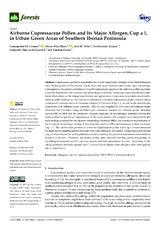Mostrar el registro sencillo del ítem
Airborne Cupressaceae Pollen and Its Major Allergen, Cup a 1, in Urban Green Areas of Southern Iberian Peninsula
| dc.contributor.author | Linares, Concepción De | |
| dc.contributor.author | Plaza, María Pilar | |
| dc.contributor.author | Valle, Ana M. | |
| dc.contributor.author | Alcázar, Purificación | |
| dc.contributor.author | Díaz de la Guardia, Consuelo | |
| dc.contributor.author | Galán, Carmen | |
| dc.date.accessioned | 2024-02-16T12:38:34Z | |
| dc.date.available | 2024-02-16T12:38:34Z | |
| dc.date.issued | 2021 | |
| dc.identifier.isbn | 1999-4907 | |
| dc.identifier.uri | http://hdl.handle.net/10396/27508 | |
| dc.description.abstract | Cupressaceae pollen is responsible for winter respiratory allergies in the Mediterranean area. Pollen grains of this diverse family share the same characteristics under light microscopy. Consequently, the partial contribution of each Cupressaceae species to the airborne pollen spectrum cannot be determined with conventional aerobiological methods. Studies on major aeroallergens offer better information on the allergic sensitization and appearance of symptoms in patients sensitized to airborne pollen and spores. Our aim was to determine if airborne Cupressaceae pollen concentrations correspond to aerodynamics of the major allergen of Cupressus (Cup a 1), as well as the aeroallergen correlation with different-sized particles. The air was sampled in two cities of Southern Spain (Granada and Córdoba) using the Hirst-type volumetric sampler for airborne pollen detection during 2006 to 2008 and the Andersen Cascade Impactor for aeroallergen detection during the main pollination period of Cupressaceae in the same period. The samples were analyzed by the methodology proposed by the Spanish Aerobiology Network (REA), the minimum requirements of the European Aeroallergen Society (EAS) for pollen, and by ELISA immunoassay to detect airborne Cup a 1. The distribution patterns of airborne Cupressaceae pollen and Cup a 1 were observed throughout the sampling period, although with some irregular oscillations. Cupressaceae pollen and Cup a 1 showed positive and significant correlation during the period of maximum concentrations (January to March). However, the results of this study showed that the period of exposure of aeroallergens depends on the Cupressus species and their abundance in cities. According to the allergy potential obtained, species like C. arizonica could release more allergens than other species like C. sempervirens. | es_ES |
| dc.format.mimetype | application/pdf | es_ES |
| dc.language.iso | spa | es_ES |
| dc.publisher | MDPI | es_ES |
| dc.rights | https://creativecommons.org/licenses/by/4.0/ | es_ES |
| dc.source | Forest 12, 254 (2024) | es_ES |
| dc.subject | Allergens | es_ES |
| dc.subject | Cup a 1 | |
| dc.subject | Cupressaceae pollen | |
| dc.subject | PM10 | |
| dc.subject | PM2.5 | |
| dc.subject | Airborne pollution | |
| dc.title | Airborne Cupressaceae Pollen and Its Major Allergen, Cup a 1, in Urban Green Areas of Southern Iberian Peninsula | es_ES |
| dc.type | info:eu-repo/semantics/article | es_ES |
| dc.relation.publisherversion | https://doi.org/10.3390/f12020254 | es_ES |
| dc.rights.accessRights | info:eu-repo/semantics/openAccess | es_ES |

